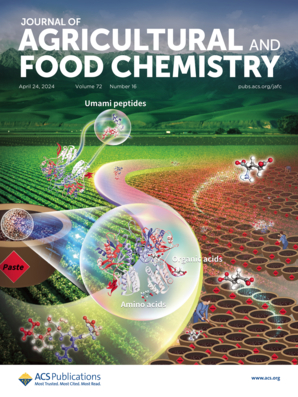How to Control the Release Behavior of Insect Sex Pheromones Using Nanomicro Fiber: Insights from Experiment and Molecular Dynamics Simulation.
IF 6.2
1区 农林科学
Q1 AGRICULTURE, MULTIDISCIPLINARY
引用次数: 0
Abstract
Polymer-based electrospun fibers can effectively sustain pheromone release for pest control, yet their regulatory mechanisms remain unclear. In this study, fibers from various polymers were loaded with multicomponent sex pheromones of Grapholitha molesta and characterized. Release tests showed that poly(3-hydroxybutyrate-co-4-hydroxybutyrate) (PHB) fibers released 90% of pheromones in 81.93 days, compared to 14.01 days for polycaprolactone fibers. Molecular dynamics (MD) simulations revealed that pheromones diffused through the polymer network via vibrations, cavity formation, and jumping. PHB fibers exhibited the lowest diffusion coefficient (0.0064 × 10-9 m2 s-1) and highest activation energy (24.56 kJ mol-1). Additionally, PHB exhibited good crystallinity and crystal arrangement, thereby enhancing the restriction on pheromone molecules. By combining MD simulations with experimental studies, molecular structure, intermolecular forces, and crystallinity were identified as the main factors regulating the release behavior of these polymer fibers. Finally, trapping experiments confirmed their effectiveness, indicating that release studies can guide field applications.利用纳米微纤维控制昆虫性信息素的释放行为:来自实验和分子动力学模拟的见解。
聚合物基静电纺丝纤维可以有效地维持害虫信息素的释放,但其调控机制尚不清楚。在本研究中,利用不同聚合物制成的纤维,负载多组分性信息素,并对其进行了表征。释放试验表明,聚(3-羟基丁酸-co-4-羟基丁酸)(PHB)纤维在81.93天释放90%的信息素,而聚己内酯纤维在14.01天释放90%的信息素。分子动力学(MD)模拟表明,信息素通过振动、空腔形成和跳跃在聚合物网络中扩散。PHB纤维的扩散系数最低(0.0064 × 10-9 m2 s-1),活化能最高(24.56 kJ mol-1)。此外,PHB具有良好的结晶度和晶体排列,从而增强了对信息素分子的限制。通过MD模拟与实验研究相结合,确定了分子结构、分子间力和结晶度是调控这些聚合物纤维释放行为的主要因素。捕集实验验证了该方法的有效性,表明释放研究可以指导田间应用。
本文章由计算机程序翻译,如有差异,请以英文原文为准。
求助全文
约1分钟内获得全文
求助全文
来源期刊
CiteScore
9.90
自引率
8.20%
发文量
1375
审稿时长
2.3 months
期刊介绍:
The Journal of Agricultural and Food Chemistry publishes high-quality, cutting edge original research representing complete studies and research advances dealing with the chemistry and biochemistry of agriculture and food. The Journal also encourages papers with chemistry and/or biochemistry as a major component combined with biological/sensory/nutritional/toxicological evaluation related to agriculture and/or food.

 求助内容:
求助内容: 应助结果提醒方式:
应助结果提醒方式:


